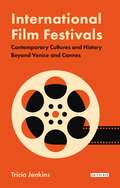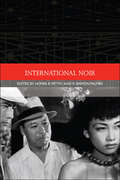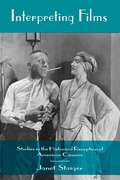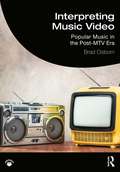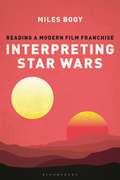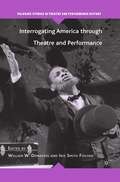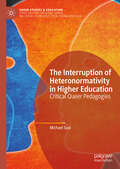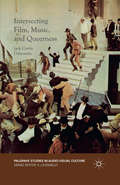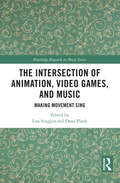- Table View
- List View
International Film Festivals: Contemporary Cultures and History Beyond Venice and Cannes (International Library of the Moving Image (PDF))
by Tricia JenkinsMore than 5,000 film festivals take place globally and many of these have only been established in the last two decades. International Film Festivals collects the leading scholarship on this increasingly prominent phenomenon from both historical and contemporary perspectives, using diverse methods including archival research, interviews and surveys and drawing widely from fields like sociology, urban studies and film criticism to patent technology and history. With contributors from across the world and covering the major festivals - Cannes, Venice, Toronto, Berlin - as well as niche, genre and online film festivals, this book is an authoritative and exemplary guide to the evolution of these key sites for film distribution, exhibition and reception. Chapters unravel topics such as the relationship between corporations and festivals, the soft power function they can perform for their host nations and the changing identities of audiences on arrival at, and during exploration of, a given festival venue. Tricia Jenkins' edited volume reconceives the film festival for the global, digital age whilst drawing out its historic importance and ultimately makes a major intervention in film festival studies as well as film and cultural studies more widely.
International Film Festivals: Contemporary Cultures and History Beyond Venice and Cannes (International Library of the Moving Image (PDF))
by Tricia JenkinsMore than 5,000 film festivals take place globally and many of these have only been established in the last two decades. International Film Festivals collects the leading scholarship on this increasingly prominent phenomenon from both historical and contemporary perspectives, using diverse methods including archival research, interviews and surveys and drawing widely from fields like sociology, urban studies and film criticism to patent technology and history. With contributors from across the world and covering the major festivals - Cannes, Venice, Toronto, Berlin - as well as niche, genre and online film festivals, this book is an authoritative and exemplary guide to the evolution of these key sites for film distribution, exhibition and reception. Chapters unravel topics such as the relationship between corporations and festivals, the soft power function they can perform for their host nations and the changing identities of audiences on arrival at, and during exploration of, a given festival venue. Tricia Jenkins' edited volume reconceives the film festival for the global, digital age whilst drawing out its historic importance and ultimately makes a major intervention in film festival studies as well as film and cultural studies more widely.
International Handbook of Research in Arts Education (Springer International Handbooks of Education #16)
by Liora BreslerProviding a distillation of knowledge in the various disciplines of arts education (dance, drama, music, literature and poetry and visual arts), this essential handbook synthesizes existing research literature, reflects on the past, and contributes to shaping the future of the respective and integrated disciplines of arts education. While research can at times seem distant from practice, the Handbook aims to maintain connection with the live practice of art and of education, capturing the vibrancy and best thinking in the field of theory and practice. The Handbook is organized into 13 sections, each focusing on a major area or issue in arts education research.
International Law and International Security: Military and Political Dimensions - A U.S.-Soviet Dialogue
by Paul B. Stephan, III Boris M. KlimenkoThis volume brings together experts and political actors from the United States and the USSR to assess the status of international law in the post-Cold War era with the intention of contributing ideas, judgements, and proposals tempered by experience. The topics covered range from terrorism to peaceful conflict resolution; from the renunciation of aggression to the right of self-defence; from chemical, biological, and nuclear weapons limitations to problems of verification; and from the military use of space to the right of political self-determination. Each chapter features contributions by both US and Soviet experts who have themselves participated in high-level policy making and international negotiations in the area (including, for example, the ABM, SALTI, SALTII, CFE, and START talks).
International Law and International Security: Military and Political Dimensions - A U.S.-Soviet Dialogue
by Paul B. Stephan, III Boris M. KlimenkoThis volume brings together experts and political actors from the United States and the USSR to assess the status of international law in the post-Cold War era with the intention of contributing ideas, judgements, and proposals tempered by experience. The topics covered range from terrorism to peaceful conflict resolution; from the renunciation of aggression to the right of self-defence; from chemical, biological, and nuclear weapons limitations to problems of verification; and from the military use of space to the right of political self-determination. Each chapter features contributions by both US and Soviet experts who have themselves participated in high-level policy making and international negotiations in the area (including, for example, the ABM, SALTI, SALTII, CFE, and START talks).
International Noir (Traditions in World Cinema)
by Homer B. Pettey R. Barton PalmerFollowing World War II, film noir became the dominant cinematic expression of Cold War angst, influencing new trends in European and Asian filmmaking. International Noir examines film noir’s influence on the cinematic traditions of Britain, France, Scandinavia, Japan, Hong Kong, Korea, and India. This book suggests that the film noir style continues to appeal on such a global scale because no other cinematic form has merged style and genre to effect a vision of the disturbing consequences of modernity. International noir has, however, adapted and adopted noir themes and aesthetic elements so that national cinemas can boast an independent and indigenous expression of the genre. Ranging from Japanese silent films and women’s films to French, Hong Kong, and Nordic New Waves, this book also calls into question critical assessments of noir in international cinemas. In short, it challenges prevailing film scholarship to renegotiate the concept of noir. Ending with an examination of Hollywood’s neo-noir recontextualization of the genre, and post-noir’s reinvigorating critique of this aesthetic, International Noir offers Film Studies scholars an in-depth commentary on this influential global cinematic art form, further offering extensive bibliography and filmographies for recommended reading and viewing.
The international politics of the Middle East: Second edition (Regional International Politics)
by Raymond HinnebuschOne of the major internationally recognised works on the international politics of the Middle East, this book systematically combines International Relations theory and Middle East case studies to provide a macro overview of the international relations of the region. The book has been widely used at both undergraduate levels, Masters degree and PhD levels. In providing a unique interpretation of Middle East North African (MENA) international politics, it will also be valuable for scholars of the region. The book provide readers with both theoretical and concrete information, with theoretically-framed major topics, liberally illustrated with case study material on key dimensions of regional politics. Topics include the place of the Middle East in the wider global system; the role of Arabism and Islam in regional politics; the impact of state formation in the region on its international relations; comparative foreign policy making looking at pivotal country cases, including Egypt, Syria, Saudi Arabia and Turkey; major regional wars and efforts at order building; the role of US hegemony and the two Iraq wars; and the impact of the Arab Uprising on regional politics.
The international politics of the Middle East: Second edition (Regional International Politics)
by Raymond HinnebuschOne of the major internationally recognised works on the international politics of the Middle East, this book systematically combines international relations theory and Middle East case studies to provide a macro overview of the international relations of the region. The book has been widely used at both undergraduate levels, Masters degree and PhD levels. In providing a unique interpretation of Middle East North Africa (MENA) international politics, it will also be valuable for scholars of the region. The book provide readers with both theoretical and concrete information, with theoretically-framed major topics, liberally illustrated with case study material on key dimensions of regional politics. Topics include the place of the Middle East in the wider global system; the role of Arabism and Islam in regional politics; the impact of state formation in the region on its international relations; comparative foreign policy making looking at pivotal country cases, including Egypt, Syria, Saudi Arabia and Turkey; major regional wars and efforts at order building; the role of US hegemony and the two Iraq wars; and the impact of the Arab Uprising on regional politics.
Interpretation and Film Studies: Movie Made Meanings
by Phillip NovakThis book argues that the sustained interpretation of individual movies has, contrary to conventional wisdom, never been a major preoccupation of film studies—that, indeed, the field is marked by a dearth of effective, engaging, and enlightening critical analyses of single films. The book makes this case by surveying what has been written about four historically important and well-known movies (D. W. Griffith’s Way Down East, Marcel Carné’s Port of Shadows, Mike Nichols’s The Graduate, and Michelangelo Antonioni’s Red Desert), none of which has been the focus of sustained critical attention, and by exhaustively examining the kinds of work published in four influential film journals (Cinema Journal, Screen, Wide Angle, and Movie). The book goes on to argue for the value of the work of interpretation, illustrating this value through extended analyses of Roman Polanski’s Chinatown and Christopher Nolan’s Memento, both of which thematize interpretation. Novak demonstrates the causes and consequences of reading poorly and the importance of reading well.
Interpreting Films: Studies in the Historical Reception of American Cinema
by Janet StaigerEmploying a wide range of examples from Uncle Tom's Cabin and Birth of a Nation to Zelig and Personal Best, Janet Staiger argues that a historical examination of spectators' responses to films can make a valuable contribution to the history, criticism, and philosophy of cultural products. She maintains that as artifacts, films do not contain immanent meanings, that differences among interpretations have historical bases, and that these variations are due to social, political, and economic conditions as well as the viewers' constructed images of themselves. After proposing a theory of reception study, the author demonstrates its application mainly through analyzing the varying responses of audiences to certain films at specific moments in history. Staiger gives special attention to how questions of class, gender, sexual preference, race, and ethnicity enter into film viewers' interpretations. Her analysis reflects recent developments in post-structuralism, cognitive psychology, psychoanalysis, and cultural studies, and includes a discussion of current reader-response models in literary and film studies as well as an alternative approach for thinking about historical readers and spectators.
Interpreting Films: Studies in the Historical Reception of American Cinema
by Janet StaigerEmploying a wide range of examples from Uncle Tom's Cabin and Birth of a Nation to Zelig and Personal Best, Janet Staiger argues that a historical examination of spectators' responses to films can make a valuable contribution to the history, criticism, and philosophy of cultural products. She maintains that as artifacts, films do not contain immanent meanings, that differences among interpretations have historical bases, and that these variations are due to social, political, and economic conditions as well as the viewers' constructed images of themselves. After proposing a theory of reception study, the author demonstrates its application mainly through analyzing the varying responses of audiences to certain films at specific moments in history. Staiger gives special attention to how questions of class, gender, sexual preference, race, and ethnicity enter into film viewers' interpretations. Her analysis reflects recent developments in post-structuralism, cognitive psychology, psychoanalysis, and cultural studies, and includes a discussion of current reader-response models in literary and film studies as well as an alternative approach for thinking about historical readers and spectators.
Interpreting Music Video: Popular Music in the Post-MTV Era
by Brad OsbornInterpreting Music Video introduces students to the musical, visual, and sociological aspects of music videos, enabling them to critically analyze a multimedia form with a central place in popular culture. With highly relevant examples drawn from recent music videos across many different genres, this concise and accessible book brings together tools from musical analysis, film and media studies, gender and sexuality studies, and critical race studies, requiring no previous knowledge. Exploring the multiple dimensions of music videos, this book is the perfect introduction to critical analysis for music, media studies, communications, and popular culture.
Interpreting Music Video: Popular Music in the Post-MTV Era
by Brad OsbornInterpreting Music Video introduces students to the musical, visual, and sociological aspects of music videos, enabling them to critically analyze a multimedia form with a central place in popular culture. With highly relevant examples drawn from recent music videos across many different genres, this concise and accessible book brings together tools from musical analysis, film and media studies, gender and sexuality studies, and critical race studies, requiring no previous knowledge. Exploring the multiple dimensions of music videos, this book is the perfect introduction to critical analysis for music, media studies, communications, and popular culture.
Interpreting Star Wars: Reading a Modern Film Franchise
by Miles BooyUpon its initial release in 1977, many critics regarded Star Wars as a childish retort to the mature American cinema of the seventies. Though full of sound and fury, some felt that it signified nothing. Four decades later, the significations are multiple as interpretations of the film's strange imagery and metaphoric potential continue to pile up. Interpreting Star Wars analyses and contextualises the dominant trends in Star Wars interpretation from the earliest reviews, through Lucasfilm's attempts to use its position as copyright holder to promote a single meaning, to the 21st century where the internet has rendered such authorial control impossible and new entries to the canon present new twists on old hopes.
Interpreting Star Wars: Reading a Modern Film Franchise
by Miles BooyUpon its initial release in 1977, many critics regarded Star Wars as a childish retort to the mature American cinema of the seventies. Though full of sound and fury, some felt that it signified nothing. Four decades later, the significations are multiple as interpretations of the film's strange imagery and metaphoric potential continue to pile up. Interpreting Star Wars analyses and contextualises the dominant trends in Star Wars interpretation from the earliest reviews, through Lucasfilm's attempts to use its position as copyright holder to promote a single meaning, to the 21st century where the internet has rendered such authorial control impossible and new entries to the canon present new twists on old hopes.
Interrogating America through Theatre and Performance (Palgrave Studies in Theatre and Performance History)
by Iris Smith FischerThis collection of essays dissects American plays, movies and other performance types that examine America and its history and culture. From Amerindian stage performances to AIDS and post-9/11 America, it displays the various and important ways theatre and performance studies have examined and conversed with American culture and history.
The Interruption of Heteronormativity in Higher Education: Critical Queer Pedagogies (Queer Studies and Education)
by Michael SealThis book examines how heteronormativity in higher education can be interrupted and resisted. Located within the theoretical framework of queer and critical pedagogy and based on extensive empirical research, the author explores the dynamics of heteronormativity and its interruption on professional courses in a range of higher education institutions. Reactions to attempt to interrupt it were nuanced: while strategies of contested engagement, avoidance and retreat were expressed, heterosexualities were largely un-examined and un-articulated. ‘Coming out’ needs to be a pedagogical act, carried out concurrently with the interruptions of other social constructions and binary oppositions. The author calls for co-created and co-held meta-reflexive and liminal spaces that emphasise inter-subjectivity, encounters, and working in the moment. These spaces must de-construct and reconstruct pedagogical power and knowledge to promote collective intersubjective consciousnesses, and widen the vision of the reflective practitioner to that of the pedagogical practitioner. This pioneering book is a call to action to all those concerned with interrupting and problematising presumed binary categories of sexuality within the heterosexual matrix.
Intersecting Art and Technology in Practice: Techne/Technique/Technology (Routledge Advances in Art and Visual Studies)
by Camille C. Baker Kate SicchioThis book focuses on the artistic process, creativity and collaboration, and personal approaches to creation and ideation, in making digital and electronic technology-based art. Less interested in the outcome itself – the artefact, artwork or performance – contributors instead highlight the emotional, intellectual, intuitive, instinctive and step-by-step creation dimensions. They aim to shine a light on digital and electronic art practice, involving coding, electronic gadgetry and technology mixed with other forms of more established media, to uncover the practice-as-research processes required, as well as the collaborative aspects of art and technology practice.
Intersecting Art and Technology in Practice: Techne/Technique/Technology (Routledge Advances in Art and Visual Studies)
by Camille C Baker and Kate SicchioThis book focuses on the artistic process, creativity and collaboration, and personal approaches to creation and ideation, in making digital and electronic technology-based art. Less interested in the outcome itself – the artefact, artwork or performance – contributors instead highlight the emotional, intellectual, intuitive, instinctive and step-by-step creation dimensions. They aim to shine a light on digital and electronic art practice, involving coding, electronic gadgetry and technology mixed with other forms of more established media, to uncover the practice-as-research processes required, as well as the collaborative aspects of art and technology practice.
Intersecting Cultures in Music and Dance Education: An Oceanic Perspective (Landscapes: the Arts, Aesthetics, and Education #19)
by Linda Ashley David LinesThis volume looks forward and re-examines present day education and pedagogical practices in music and dance in the diverse cultural environments found in Oceania. The book also identifies a key issue of how teachers face the prospect of taking a reflexive view of their own cultural legacy in music and dance education as they work from and alongside different cultural worldviews. This key issue, amongst other debates that arise, positions Intersecting Cultures as an innovative text that fills a gap in the current market with highly appropriate and fresh ideas from primary sources. The book offers commentaries that underpin and inform current pedagogy and bigger picture policy for the performing arts in education in Oceania, and in parallel ways in other countries.
Intersecting Film, Music, and Queerness (Palgrave Studies in Audio-Visual Culture)
by Jack Curtis DubowskyIntersecting Film, Music, and Queerness uses musicology and queer theory to uncover meaning and message in canonical American cinema. This study considers how queer readings are reinforced or nuanced through analysis of musical score. Taking a broad approach to queerness that questions heteronormative and homonormative patriarchal structures, binary relationships, gender assumptions and anxieties, this book challenges existing interpretations of what is progressive and what is retrogressive in cinema. Examined films include Bride of Frankenstein, Louisiana Story, Rudolph the Red-Nosed Reindeer, Blazing Saddles, Edward Scissorhands, Brokeback Mountain, Boys Don't Cry, Transamerica, Thelma & Louise, Go Fish and The Living End, with special attention given to films that subvert or complicate genre. Music is analyzed with concern for composition, intertextual references, absolute musical structures, song lyrics, recording, arrangement, and performance issues. This multidisciplinary work, featuring groundbreaking research, analysis, and theory, offers new close readings and a model for future scholarship.
Intersecting Genre: A Skills-based Approach to Creative Writing
by Dr Jason OlsenCreative writing takes on many genres, or forms: fiction, poetry, nonfiction and dramatic writing. Whilst all have their own principles and 'rules', all modes of writing overlap and borrow from each other, and so what you learn in one form can influence, inform and inspire your practice in others. Intersecting Genre holds this idea at its heart, embracing the dissolution of disciplinary and genre boundaries to discuss the ways each genre supports the others. Whilst traditional approaches typically discuss one genre independent of others, this book explores genre relationships with each chapter focusing on the intersection between 2 modes and what you can learn and the skills you can transfer by combining the wisdom gained from the study of, for example, fiction and poetry together.With most introductory creative writing courses aiming to apprise you of such mechanics of writing as narrative, pace, vocabulary, dialogue, imagery and viewpoint, Intersecting Genre is the ideal companion, offering a unique methodology that analyses these ideas as they feature across the different genres, thus giving you the ultimate, well-rounded introduction before you settle into the modes of writing that best suit you as your progress with your writing. Covering fiction, poetry, nonfiction, writing plays and screenwriting, and also taking stock of the forms that do not fit neatly into any genre silo, this book uses models, critical questions, writing warm-ups and writing practice exercises to give you a solid understanding of the points discussed and encouraging you to put them to practice in your own work. With the field of creative writing evolving constantly, and with approaches to teaching and learning the subject vast and continually expanding, this book offers a dynamic, and uniquely holistic method for developing your writing skills, asking you to deeply consider the issues, and possibilities, present in genre.
Intersecting Genre: A Skills-based Approach to Creative Writing
by Dr Jason OlsenCreative writing takes on many genres, or forms: fiction, poetry, nonfiction and dramatic writing. Whilst all have their own principles and 'rules', all modes of writing overlap and borrow from each other, and so what you learn in one form can influence, inform and inspire your practice in others. Intersecting Genre holds this idea at its heart, embracing the dissolution of disciplinary and genre boundaries to discuss the ways each genre supports the others. Whilst traditional approaches typically discuss one genre independent of others, this book explores genre relationships with each chapter focusing on the intersection between 2 modes and what you can learn and the skills you can transfer by combining the wisdom gained from the study of, for example, fiction and poetry together.With most introductory creative writing courses aiming to apprise you of such mechanics of writing as narrative, pace, vocabulary, dialogue, imagery and viewpoint, Intersecting Genre is the ideal companion, offering a unique methodology that analyses these ideas as they feature across the different genres, thus giving you the ultimate, well-rounded introduction before you settle into the modes of writing that best suit you as your progress with your writing. Covering fiction, poetry, nonfiction, writing plays and screenwriting, and also taking stock of the forms that do not fit neatly into any genre silo, this book uses models, critical questions, writing warm-ups and writing practice exercises to give you a solid understanding of the points discussed and encouraging you to put them to practice in your own work. With the field of creative writing evolving constantly, and with approaches to teaching and learning the subject vast and continually expanding, this book offers a dynamic, and uniquely holistic method for developing your writing skills, asking you to deeply consider the issues, and possibilities, present in genre.
The Intersection of Animation, Video Games, and Music: Making Movement Sing (Routledge Research in Music)
by Lisa Scoggin and Dana PlankIn both video games and animated films, worlds are constructed through a combination of animation, which defines what players see on the screen, and music and sound, which provide essential cues to action, emotion, and narrative. This book offers a rich exploration of the intersections between animation, video games, and music and sound, bringing together a range of multidisciplinary lenses. In fourteen chapters, the contributors consider similarities and differences in how music and sound structure video games and animation, as well as the animation within video games, and explore core topics of nostalgia, adaptation, gender and sexuality. Offering fresh insights into the aesthetic interplay of animation, video games, and sound, this volume provides a gateway into new areas of study that will be of interest to scholars and students across musicology, animation studies, game studies, and media studies more broadly.
The Intersection of Animation, Video Games, and Music: Making Movement Sing (Routledge Research in Music)
In both video games and animated films, worlds are constructed through a combination of animation, which defines what players see on the screen, and music and sound, which provide essential cues to action, emotion, and narrative. This book offers a rich exploration of the intersections between animation, video games, and music and sound, bringing together a range of multidisciplinary lenses. In fourteen chapters, the contributors consider similarities and differences in how music and sound structure video games and animation, as well as the animation within video games, and explore core topics of nostalgia, adaptation, gender and sexuality. Offering fresh insights into the aesthetic interplay of animation, video games, and sound, this volume provides a gateway into new areas of study that will be of interest to scholars and students across musicology, animation studies, game studies, and media studies more broadly.
